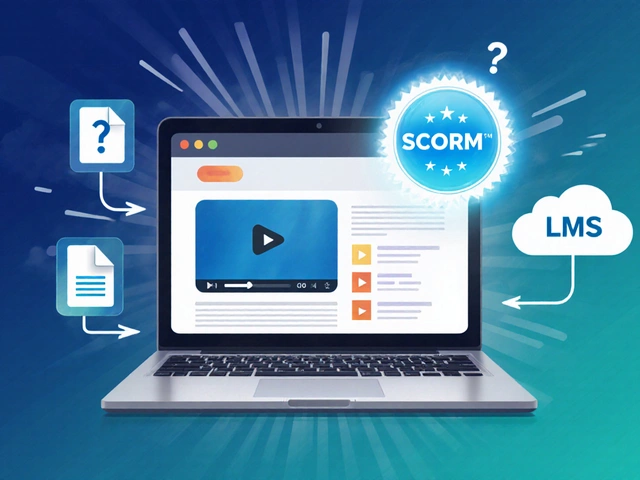
In today's digital age, creating an online course is an exciting opportunity for anyone looking to share their knowledge and skills with a global audience. The best part? You can get started without spending a dime. Whether you're a teacher, a professional, or a hobbyist, the tools and platforms available today make it possible to design and launch your very own course online.
The idea of developing an online course may seem daunting at first, but with the right guidance, it becomes an achievable task. From choosing the ideal platform to engaging your learners, each step is a gateway to making education accessible to all. Let's dive into the process, uncover valuable tips, and turn your expertise into an online learning experience that stands out.
- Essential Tools for Course Creation
- Choosing the Right Platform
- Structuring Your Course Content
- Engaging Your Audience
- Promoting and Growing Your Course
Essential Tools for Course Creation
Setting out on the journey of creating a free online course involves tapping into a variety of resources that are at your disposal. In this digital era, the arsenal of tools you can access provides remarkable convenience and versatility. You'll want to get equipped with some core essentials that cover everything from content creation to video editing and presentation. One key ingredient in your toolkit is a reliable computer with internet access—this is your primary workstation where all the magic happens. Many successful educators recommend starting by listing down all the topics and materials you want to cover in your course. This serves as a roadmap that guides the entire process and ensures nothing important is left out.
When it comes to designing educational content, tools like Canva and Google Slides come in handy for crafting visually appealing presentations. These tools offer a range of templates and design elements that can enhance learning experiences. You might also find Open Broadcaster Software (OBS Studio) useful for recording lectures or tutorials—it’s free and perfect for both live streams and pre-recorded sessions. Don’t shy away from utilizing your smartphone either. Many modern smartphones have high-quality cameras that can be perfect for recording lectures on the go. As Steve Jobs once said,
"Technology alone is not enough; it’s technology married with liberal arts, married with the humanities, that yields us the results that make our hearts sing."
Another critical component is the software for writing and organizing your course material. Google Docs is an excellent tool for collaborating with others if you're working in a team. It allows you to maintain consistency and accuracy across all course materials. For video editing, Lightworks and Shotcut are fantastic free options that support all major platforms. They offer a range of editing features that can help you create crisp, engaging video lectures. Stay mindful of sound quality as well—a simple external microphone can drastically improve audio clarity, making lessons more enjoyable for your learners.
To streamline the course development process, consider project management tools like Trello or Asana. These help in organizing tasks, setting deadlines, and tracking progress. Engaging tools like Kahoot! and Quizlet can also be integrated into your course to create interactive quizzes and games, enhancing learner engagement and retention. In fact, studies suggest that incorporating interactive tools can boost learning outcomes by up to 30%.
| Tool Type | Recommended Tools |
|---|---|
| Presentation | Canva, Google Slides |
| Video Recording | OBS Studio, Smartphone Camera |
| Text Editing | Google Docs |
| Video Editing | Lightworks, Shotcut |
| Project Management | Trello, Asana |
Choosing the Right Platform
Selecting the ideal platform for your online course creation is like finding the perfect venue for an event. You want a space that's accessible, user-friendly, and packed with features that enhance both teaching and learning experiences. In today's digital landscape, the options are both varied and robust, ranging from specialized e-learning sites to general-purpose platforms that have incorporated educational tools.
Think of platforms like Coursera, Udemy, or Teachable, each catering to different needs and audiences. For instance, if you're looking at offering professional-level courses, Coursera might be your go-to, as it partners with universities and institutions worldwide. On the other hand, platforms like Udemy are excellent for beginners wishing to test the waters in selling and creating their first course. These platforms offer a streamlined process to set up your class, upload content, and integrate quizzes and assignments. A significant draw is their marketing potential, meaning once your course hits the shelves, millions globally can see and enroll in it.
Technologically savvy instructors might lean towards open-source platforms like Moodle, where customization is key. With such platforms, there's a world of flexibility in branding and user experience. If tech isn't your strong suit, however, platforms providing round-the-clock support, such as Thinkific, ensure you’re never left alone to figure things out. Even social media giants like Facebook and YouTube have evolved into educational hubs, offering community-building tools and interactive video functionalities. A particularly engaging feature of these platforms is the live streaming classes option, which taps into a learner's sense of real-time connection.
According to a survey by the Online Learning Consortium, 73% of instructors noted an increase in student engagement when utilizing interactive platform features.
While contemplating platforms, it becomes crucial to think through other features too. Features such as mobile compatibility, ease of payment processing, and availability of analytical tools to track your course's performance can make a noticeable difference. For example, auto-graded quizzes might attract instructors who want to reduce manual grading efforts, while forums and discussion boards can enhance the learning environment by fostering community interaction. Some platforms also provide seamless integration with existing tools like Google Apps and Zoom.
A closely related consideration is revenue sharing. Platforms like Udemy usually take a percentage of your earnings in exchange for their vast reach, while others like Teachery work with a fixed monthly fee, letting you keep 100% of your earnings post fee. The right platform for one isn’t always the right pick for another. Thus, it becomes essential to weigh your options, considering both your needs as an instructor and those of your potential students. To make an informed decision, take advantage of free trials offered by these platforms. They let you experiment with the features yourself, giving you firsthand insight into what suits you best.
Concluding this section, the process of choosing a platform is deeply personal and strategic. It reflects on what you foresee your educational content achieving. The available technology in 2025 allows you to dream big and execute efficiently, turning expert insights into compelling, interactive learning experiences. The journey of sharing your knowledge with people around the world really starts with this all-important step.

Structuring Your Course Content
Creating the perfect structure for your online course can feel like putting together a complex jigsaw puzzle. Designing a course that keeps learners engaged while effectively imparting knowledge requires a clear and well-thought-out strategy. Begin by defining your target audience and understanding their needs. This will guide you in tailoring your lessons to fit their learning style and comprehension level.
Next, decide on the broad outcomes of your course. What do you want your students to achieve by the end? These outcomes will act as checkpoints on your course-creation journey, aiding you in staying focused. Break these outcomes into smaller, manageable modules. Each module should cover a specific component of your course. Think of these modules as chapters in a book, each one building on the last to form a comprehensive body of knowledge.
Within each module, think about diversifying teaching methods to maintain engagement. Incorporate various media types such as video lectures, slideshows, quizzes, and interactive activities. Studies have shown that mixed-media approaches cater to different learning preferences and improve content retention. According to a report from the University of Wisconsin-Madison, interactive elements in e-learning increase retention rates by up to 25%.
"The hallmark of a great online course is its ability to transform learners from passive recipients to active participants," says Dr. Ellen Arnold, expert in digital learning strategies.
Don't forget to include regular assessments to gauge your learners' understanding. This feedback loop allows you to tweak subsequent content and ensure your students grasp the key concepts effectively. Quizzes, assignments, and discussions can help reinforce knowledge and encourage application in real-world scenarios. Remember, the goal is not just to educate but to empower your students to utilize their newfound skills.
As you structure your content, leverage the power of pacing. Pace your lessons to ensure a steady flow of information. Avoid overloading your students with too much information at once. It's essential to maintain a balance between challenging your learners and preventing cognitive overload. Use headers, bullet points, and numbered lists in your course materials to help divide information into digestible portions.
Finally, always be open to revisions. As times change and your domain evolves, so too should your course content. Collect feedback from your learners regularly and be willing to adjust your course based on their input. As the landscape of digital teaching continually changes, flexibility in your course structure will be key to its longevity and success.
Engaging Your Audience
Captivating your learners' interest is crucial to the success of any online course. People today are bombarded with tons of information daily, and making sure your course stands out requires creativity and understanding of your audience’s needs. Initially, you'll want to start by defining who your audience is. Are they beginners, or do they have some prior knowledge? Knowing this will tailor your content to suit their level and interests, keeping them interested and coming back for more.
Integrating storytelling into your lessons can be a powerful tool. Stories have the ability to transform dry information into memorable and relatable experiences. Consider sharing personal anecdotes that tie in with your lessons. This not only humanizes the instructor, creating a personal connection, but also anchors the material in real-world scenarios. Remember, learning should feel less like a chore and more like an inspiring journey.
Interactive Elements
Incorporating interactive elements can significantly enhance engagement. Instead of having learners passively consume information, invite them to participate actively. Tools like quizzes, discussion boards, and live Q&A sessions provide platforms for interaction and feedback. According to a 2023 survey by eLearning Industry, courses that featured interactive elements showed a 25% higher completion rate than those that stuck to a traditional lecture format.
"Tell me and I forget, teach me and I may remember, involve me and I learn." — Benjamin Franklin
Gamification is another trend that has proven effective in holding learner interest. By adding game-like elements such as point scoring, badges, or leaderboards, courses become not only educational but enjoyable. This strategy taps into the natural human desire for achievement and competition, motivating participants to engage more deeply with the material.
Feedback and Improvement
Feedback is a two-way street. Encourage your audience to share their thoughts on the course content and delivery. Constructive feedback offers valuable insights into what works and what doesn't, enabling you to tweak content for better engagement. Regularly updating course materials not only reflects your responsiveness but also keeps the content fresh and relevant. Engaging your audience also involves creating a community around your course. Establish online groups or forums where learners can interact with each other. When learners connect, there exists a shared sense of belonging and collective learning. This environment fosters collaboration and understanding, enriching the learning process.
Lastly, measurement of engagement is essential. Monitor metrics such as completion rates, time spent on various modules, and participation in course activities. Utilize these insights to refine your approach, ensuring your course maintains its appeal and efficacy. With the evolving landscape of digital teaching, staying informed on new trends in learner engagement will ensure your course remains impactful and enjoyable.

Promoting and Growing Your Course
Creating an online course is only half the battle; the next crucial step is promoting and growing it to reach a wide audience. With the right strategies, you can ensure your course attracts the attention it deserves. Start by leveraging your existing network. Share your course with friends, colleagues, and family through social media platforms and email. This organic reach can spark initial interest and conversation around your course. Sharing educational content for free can quickly gain traction through word-of-mouth, and leveraging personal connections can be a powerful marketing tool.
Embrace the power of storytelling to engage potential students. Create a compelling narrative about why your course is unique and how it can benefit them. Incorporate real-life success stories or testimonials from early users into your marketing materials. This helps build trust and adds credibility to your course. Consider creating short video teasers or trailers for your course. These visual snippets are a great way to capture attention on platforms like YouTube or Instagram. They provide a dynamic glimpse into what learners can expect, keeping them curious and encouraging sign-ups.
Utilize SEO strategies to ensure your course appears in search engine results. Identify keywords relevant to your course content and audience, and incorporate them naturally into your course descriptions and content. This not only improves search visibility but also helps attract digital teaching enthusiasts looking for particular skills or knowledge. Collaborate with influencers or bloggers in your course's niche. They often have dedicated followers who trust their opinions. A recommendation or shout-out from an influencer can lead to a significant boost in course enrollments.
Consider offering promotional discounts or free trials to attract a large audience quickly. Many successful online educators have used this strategy to increase enrollment and generate interest. These introductory offers lower the barrier to entry for new learners and act as a showcase for the value your course provides. Once they see the benefits, they're more likely to engage and complete the full course. Don’t forget to foster a sense of community among your learners through interactive elements like forums or live Q&A sessions. Provide opportunities for feedback and listen to your learners' suggestions. Creating a community around your course not only keeps current learners engaged but also encourages them to spread the word. Word-of-mouth is a potent force in today’s rapid information-sharing world.
As Simon Sinek eloquently states, "People don’t buy what you do; they buy why you do it." This quote emphasizes the importance of promoting your course’s purpose and values alongside its content.
Consider leveraging data-driven approaches to track your course's performance. Use analytics tools provided by many online course creation platforms to monitor student engagement and progress. This data can offer insights into which parts of the course are most appealing or which sections need improvement. Adjust your marketing strategies based on these insights to better meet the needs and expectations of your learners. This adaptive approach not only enhances learner satisfaction but also helps grow your course base over time.
Ultimately, promoting and growing your course requires creativity, persistence, and the willingness to adapt your strategies as needed. By focusing on creating value, connecting with your audience, and continually improving your course experience, you’ll be well on your way to building a thriving educational journey.







